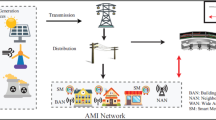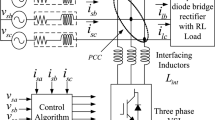Abstract
This paper proposes an event-triggered distributed control method based on state observer and multi-kernel extreme learning machine (MKELM) for direct current microgrid, which can suppress the false data injection attacks (FDIA) in system. Firstly, considering the problem that most of the methods have poor suppression capability for discrete attacks in sensor signals, an MKELM-based suppression method for sensor attack is proposed. MKELM is used to model the microgrid system, the output current estimated by MKELM is employed in the controller instead of the current value measured by sensors, thus avoiding the FDIA present in sensors. Secondly, an event-triggered state observer-based distributed secondary control method with H∞ consensus performance is designed for suppressing the FDIA in communication link. In the controller, a state variable is constructed by deriving the microgrid system expression as a first-order multi-agent system, and then a state observer is designed to observe the transmitted information for isolating and suppressing the attack signals. And it is proved theoretically that the proposed event-triggered controller can achieve H∞ consensus convergence. Finally, simulation analyses verify the effectiveness of the method for suppressing FDIA in DC microgrid system.



















Similar content being viewed by others
Data availability
The datasets generated during and/or analysed during the current study are available from the corresponding author on reasonable request.
References
Tan S, Xie P, Guerrero JM et al (2022) False data injection cyber-attacks detection for multiple DC microgrid clusters. Appl Energy 310:118425
Zhang Z, Dou C, Yue D et al (2022) Predictive voltage hierarchical controller design for islanded microgrids under limited communication. IEEE Trans Circuits Syst I Regul Pap 69(2):933–945
Dou C, Yue D, Zhang Z, Ma K (2019) MAS-based distributed cooperative control for DC microgrid through switching topology communication network with time-varying delays. IEEE Syst J 13(1):615–624
Chen Z, Yu X, Xu W et al (2021) Modeling and control of islanded DC microgrid clusters with hierarchical event-triggered consensus algorithm. IEEE Trans Circuits Syst I Regul Pap 68(1):376–386
Fan Y, Hu G, Egerstedt M (2017) Distributed reactive power sharing control for microgrids with event-triggered communication. IEEE Trans Control Syst Technol 25(1):118–128
Li Y, Zhang Z, Dragicevic T et al (2021) A unified distributed cooperative control of DC microgrids using consensus protocol. IEEE Transact Smart Grid 12(3):1880–1892
Vahidreza N, Seyedali M, Ali D et al (2015) Distributed cooperative control of DC microgrids. IEEE Trans Power Electron 30(4):2288–2303
Dong X, Ge M, Liu Z et al (2022) Distributed CPS-based model predictive compensator for DC microgrids with cyber-layer constraints. Int J Electr Power Energy Syst 143:108463
Habibi MR, Baghaee HR, Dragičević T et al (2021) Detection of false data injection cyber-attacks in DC microgrids based on recurrent neural networks. IEEE J Emerg Select Topics Power Electron 9(5):5294–5310
Ashok A, Govindarasu M, Ajjarapu V (2018) Online detection of stealthy false data injection attacks in power system state estimation. IEEE Transact Smart Grid 9(3):1636–1646
Danzi P, Angjelichinoski M, Stefanovic C et al (2019) Software-defined microgrid control for resilience against denial-of-service attacks. IEEE Transact Smart Grid 10(5):5258–5268
Pasqualetti F, Dorfler F, Bullo F (2013) Attack detection and identification in cyber-physical systems. IEEE Trans Autom Control 58(11):2715–2729
Liang G, Zhao J, Luo F, Weller SR, Dong ZY (2017) A review of false data injection attacks against modern power systems. IEEE Transact Smart Grid 8(4):1630–1638
Zuo S, Altun T, Lewis FL et al (2020) Distributed resilient secondary control of DC microgrids against unbounded attacks. IEEE Transact Smart Grid 11(5):3850–3859
Cecilia A, Dragičević T, Costa-Castelló R et al (2021) Detection and mitigation of false data in cooperative DC microgrids with unknown constant power loads. IEEE Trans Power Electron 36(8):9565–9577
Lu S, Zhang Z, Zhang Y et al (2022) CGENet: A deep graph model for COVID-19 detection based on chest CT. Biology-Basel 11(1):33
Lu S, Wang S, Zhang Y et al (2020) Detection of abnormal brain in MRI via improved AlexNet and ELM optimized by chaotic bat algorithm. Neural Comput Appl 33(17):10799–10811
Wu Y, Zhang P, Lu G (2021) Detection and location of aged cable segment in underground power distribution system using deep learning approach. IEEE Trans Industr Inf 17(11):7379–7389
Habibi MR, Baghaee HR, Dragičević T, et al (2021) False data injection cyber-attacks mitigation in parallel DC/DC converters based on artificial neural networks. IEEE Transact Circuits Syst—II: Express Briefs 68(2):717–721
Habibi MR, Baghaee HR, Blaabjerg F et al (2022) Secure MPC/ANN-based false data injection cyber-attack detection and mitigation in DC microgrids. IEEE Syst J 16(1):1487–1498
Guo X, Zhang D, Wang J et al (2022) Event-triggered observer-based H∞ consensus control and fault detection of multiagent systems under stochastic false data injection attacks. IEEE Transact Network Sci Eng 9(2):481–494
Abhinav S, Modares H, Lewis FL et al (2019) Resilient cooperative control of DC microgrids. IEEE Transact Smart Grid 10(1):1083–1085
Sahoo S, Peng JCH, Devakumar A et al (2020) On detection of false data in cooperative DC microgrids—A discordant element approach. IEEE Trans Industr Electron 67(8):6562–6571
Tang Z, Kuijper M, Chong MS et al (2019) Linear system security—Detection and correction of adversarial sensor attacks in the noise-free case. Automatica 101:53–59
Jiang Y, Yang Y, Tan S et al (2021) Distributed sliding mode observer-based secondary control for DC microgrids under cyber-attacks. IEEE J Emerg Select Topics Circuits Syst 11(1):144–154
Jiang Y, Yang Y, Tan S et al (2022) A high-order differentiator based distributed secondary control for DC microgrids against false data injection attacks. IEEE Transact Smart Grid 13(5):4035–4045
Nasirian V, Moayedi S, Davoudi A et al (2015) Distributed cooperative control of DC microgrids. IEEE Trans Power Electron 30(4):2288–2303
Cecilia A, Sahoo S, Dragičević T et al (2022) On addressing the security and stability issues due to false data injection attacks in DC microgrids—An adaptive observer approach. IEEE Trans Power Electron 37(3):2801–2814
He W, Gao X, Zhong W et al (2018) Secure impulsive synchronization control of multi-agent systems under deception attacks. Inf Sci 459(5):354–368
Ding D, Wang Z, Ho DWC et al (2017) Observer-based event-triggering consensus control for multiagent systems with lossy sensors and cyber-attacks. IEEE Transact Cybernet 47(8):1936–1947
Liu X, Wen C, Xu Q et al (2021) Resilient control and analysis for DC microgrid system under DoS and impulsive FDI attacks. IEEE Transact Smart Grid 12(5):3742–3754
Meng M, Xiao G, Li B (2020) Adaptive consensus for heterogeneous multi-agent systems under sensor and actuator attacks. Automatica 122:109242
Xie Z, Wu Z (2021) Maximum power point tracking algorithm of PV system based on irradiance estimation and multi-Kernel extreme learning machine. Sustain Energy Technol Assess 44:101090
Zhao XM, Cao WP, Zhu HY et al (2018) An initial study on the rank of input matrix for extreme learning machine. Int J Mach Learn Cybern 9(5):867–879
Zou WD, Yao FX, Zhang BH, et al (2016) Back propagation convex extreme learning machine. 7th International Conference on Extreme Learning Machines (ELM), Singapore, DEC 13–15
Cao WP, Gao JZ, Ming Z, et al (2017) Fuzziness based Random Vector Functional-link Network for Semi-supervised Learning. International Conference on Computational Science and Computational Intelligence (CSCI), Las Vegas, NV, Dec 14–16
Cao WP, Yang PF, Ming Z, et al (2020) An improved fuzziness based random vector functional link network for liver disease detection. 6th IEEE Int Conf on Big Data Security on Cloud (IEEE BigDataSecurity)/6th IEEE Int Conf High Performance and Smart Computing (IEEE HPSC)/5th IEEE Int Conf on Intelligent Data and Security (IEEE IDS), Baltimore, MD, May 25–27
Huang L, Mao X (2009) Delay-dependent exponential stability of neutral stochastic delay systems. IEEE Trans Autom Control 54(1):147–152
Acknowledgements
This project was supported by the Natural Science Foundation of Hebei Province under Grant F2020203014.
Author information
Authors and Affiliations
Corresponding author
Additional information
Publisher's Note
Springer Nature remains neutral with regard to jurisdictional claims in published maps and institutional affiliations.
Appendices
Appendix
Appendix 1: The proof of Theorem 1.
Let \(e_{{\overline{d}_{i} }} = \overline{d}_{i} - \hat{\overline{d}}_{i}\). According to Eq. (22), the derivative of \(e_{{\overline{d}_{i} }}\) is
Consider the following Lyapunov function.
where \(e_{{\overline{d}_{i} }} = \overline{d}_{i} - \hat{\overline{d}}_{i}\).
According to Definition 1, let the mathematical expectation of the infinitesimal operator for V1 be
According to Eq. (29), \({\rm E}\left\{ {\lambda {\mathbf{e}}_{X}^{{\text{T}}} {\mathbf{\tilde{\gamma }v}}} \right\} = {\rm E}\left\{ {\lambda {\mathbf{e}}_{X}^{{\text{T}}} {\mathbf{\gamma v}}} \right\}\). Based on Lemma 1, let \({\mathbf{M}}_{1} = {{\varvec{\upgamma}}},{\mathbf{M}}_{2}^{ - 1} = {\mathbf{\gamma \gamma }}\), then
Furthermore, according to Eqs. (22) and (36),
Since
then Eq. (40) can be written as
Substituting Eq. (39) and Eq. (42) into Eq. (38) yields
where \(\rho = \sum\limits_{i = 1}^{n} {\upsilon_{i} \left( {1 + \frac{1}{2}\overline{d}_{i}^{2} } \right)} + \frac{1}{2}\lambda \beta^{ - 1} \overline{v}^{{2}} \lambda_{\max } \left( {{\mathbf{\gamma \gamma }}} \right)\). Since \(\lambda_{0} > \frac{1}{2}\beta\),
where \(\overline{\rho } = \sqrt {\frac{\rho }{{\lambda \left( {\lambda_{0} - \frac{1}{2}\beta } \right)}}}\) is the upper bound of the estimation error. Therefore, the state estimation error of the observer is finally consensus bounded and the proof is finished.
Remark 5: As shown in Eq. (44), the \(\overline{\rho }\) is affected by \(\overline{d}_{i}\), \({\mathbf{\gamma v}}\) and the parameters \(\lambda ,\beta\). Larger disturbances \(d_{i}\) and frequent FDIA attacks may lead to larger estimation errors, but \(\overline{\rho }\) can be kept arbitrarily small by choosing appropriate parameters.
Appendix 2: The proof of Theorem 2.
Let the Lyapunov function be
According to Definition 1, let the mathematical expectation of the infinitesimal operator for V2 be
Since
where \(\sigma\) is a positive number. Then Eq. (46) can be expressed as
Since \(\frac{k}{2}{\mathbf{e}}^{{\text{T}}} {\mathbf{e}} = \frac{k}{2}\sum\limits_{i = 1}^{n} {\left| {e_{i} } \right|^{2} }\), according to the trigger condition of Eq. (24), we can get
Let \(\xi_{i}^{a} = \sum\limits_{{j \in N_{i} }} {a_{ij} \left( {\hat{X}_{j} - \hat{X}_{i} } \right)}\), \(\xi_{i}^{b} = X_{{{\text{ref}}}} - \hat{X}_{i}\). Then \(u_{i} = \xi_{i}^{a} + \xi_{i}^{b}\), and Eq. (51) can be written as
Since
then
So far, combining Eqs. (51)-(55), we can get
To achieve the dsired H∞ consensus performance, Eq. (57) is introduced.
where \({\mathbf{\varsigma }} = \left[ {{\mathbf{e}}_{X} ,{\mathbf{d}}} \right]^{{\text{T}}}\).
Substituting Eq. (56) into Eq. (57) yields
According to Eqs. (34) and (35), it can be guaranteed that \(J(t) < 0\). Then Eq. (59) can be obtained by integrating \(J(t) < 0\).
Therefore, the proposed event-triggered controller can achieve the desired H∞ consensus convergence performance for the system.
Next, it will be shown that the time interval between the two events is positive, i.e., the trigger condition can avoid Zeno behavior.
During \(t \in \left[ {t_{k}^{i} ,t_{k + 1}^{i} } \right)\), \(\frac{{d\left| {e_{i} \left( t \right)} \right|}}{dt} \le \left| {\dot{e}_{i} } \right|\) holds.
Since \(e_{i} = u_{i} \left( {t_{k}^{i} } \right) - u_{i} \left( t \right)\),
According to the observer in Eq. (21), let \(\theta_{i} = \sum\limits_{{j \in N_{i} }} {a_{ij} \left( {e_{Xi} - e_{Xj}^{*} } \right)} + g_{i} e_{Xi}\), then Eq. (60) can be written as
where
From Eq. (61), it can be further derived that
According to the trigger condition in Eq. (24),
Then Eq. (65) can be further derived from Eq. (64).
Therefore, this event trigger condition can avoid Zeno behavior.
Rights and permissions
Springer Nature or its licensor (e.g. a society or other partner) holds exclusive rights to this article under a publishing agreement with the author(s) or other rightsholder(s); author self-archiving of the accepted manuscript version of this article is solely governed by the terms of such publishing agreement and applicable law.
About this article
Cite this article
Xie, Z., Wu, Z. Event-triggered consensus control for DC microgrids based on MKELM and state observer against false data injection attacks. Int. J. Mach. Learn. & Cyber. 15, 775–793 (2024). https://doi.org/10.1007/s13042-023-01938-y
Received:
Accepted:
Published:
Issue Date:
DOI: https://doi.org/10.1007/s13042-023-01938-y




